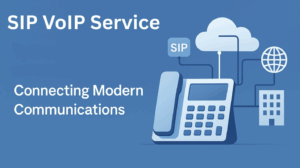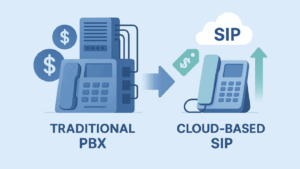
A Practical Guide to Understanding SIP Trunks
Are you looking to modernize your business communications and improve your flexibility? If so, Session Initiation Protocol (SIP) Trunks might be the game-changing solution you need.
To address your query: ‘What are SIP Trunks?’, let’s provide you with a brief yet comprehensive overview:
- SIP Trunks – These are the digital bridge, for making and receiving phone calls, as well as other communications over an internet connection.
- Purpose – They are the backbone of Voice over Internet Protocol (VoIP) technology, replacing the need for physical landlines. They consolidate multiple communication channels, effectively streamlining voice, video, and other data transmissions over the internet.
- Role in Business Communication – By facilitating VoIP and multimedia data sharing, SIP Trunks have revolutionized business communication, catering to today’s need for real-time, seamless, and cost-effective communication solutions.

But what does this mean for your business? It means addressing pain points with outdated communication systems, experiencing increased flexibility, and lowering costs while paving the way for improved efficiency and productivity. Not to mention, fast set-up and an easy-to-use control panel are just the tip of the iceberg when we talk about the benefits of SIP trunks. Wondering how this all ties up and how businesses like yours can leverage it? As we delve further into our guide, we’ll illustrate how SIP trunks could hold the key to transforming your business communications. Get ready to discover the future of business communication.
Understanding the Technical Aspects of SIP Trunks
After understanding what SIP trunks are and their role in business communication, it’s now time to go a layer deeper to comprehend the technical side of things. This includes how SIP trunks work, the architecture of SIP trunking, and the difference between SIP trunking and VoIP.
How SIP Trunks Work

To understand how SIP trunks work, we need to delve into internet protocols. SIP stands for Session Initiation Protocol, essentially a set of rules for initiating, managing, and ending data connections over the internet. In the context of SIP trunking, these connections are typically voice calls.
This digital method of making and receiving calls works by breaking up voice signals into ‘digital packets’ and sending them across a data network. Each SIP channel (the digital version of a traditional phone line) allows for two simultaneous calls – one outward and one inward. Unlike physical phone lines, you can add new SIP channels as needed without any wiring, which simplifies the process of scaling your communication needs.
The Architecture of SIP Trunking
SIP trunking requires three key components:
- An Internet Telephony Service Provider (ITSP): This is the entity that connects your business to the wider phone system over the internet.
- A PBX (Private Branch Exchange): This is your internal phone system that enables communication within your business and connects to the ITSP. The PBX can be either an older analog model or a newer digital one, as long as it’s SIP-compatible.
- A SIP Gateway: This device acts as a bridge between your ITSP and your PBX, managing the network traffic between them.
The Difference Between SIP Trunking and VoIP
SIP Trunking and VoIP (Voice over Internet Protocol) are both technologies that enable voice communication over the internet, but they serve different purposes and offer different capabilities.
VoIP is a broad term that applies to any phone call made over the internet, rather than traditional phone lines. It uses packet switching technology to transmit voice calls as data over the internet. VoIP alone, however, only supports voice communication.
SIP Trunking, on the other hand, is a specific type of VoIP technology. It acts as a virtual phone line and uses the same packet-switching technology as VoIP. But unlike VoIP, SIP trunking supports not just voice, but also video, messaging, and fax. This makes SIP Trunking a more versatile solution for businesses that require diverse communication capabilities.
Understanding these technical aspects of SIP Trunks helps you make a more informed decision about whether they’re right for your business. Armed with this knowledge, you can better assess the potential benefits of SIP Trunks, which we’ll cover in the next section.
The Benefits of Using SIP Trunks
As you explore the answer to “what are sip trunks”, it’s important to consider the numerous advantages that this technology provides. From cost savings to enhanced flexibility, SIP Trunks offer a range of benefits that can help streamline your business’s communication.
Cost-Effectiveness of SIP Trunks
One of the most significant advantages of SIP Trunking is its potential for cost savings. Traditional phone lines can be quite expensive, especially if you have multiple unused lines or make regular international calls. Additionally, you also have to factor in the hardware and maintenance costs associated with traditional phone systems.
With SIP Trunks, you only pay for what you use, making it a more economical choice. The pricing generally consists of a setup fee, a monthly rental charge for the broadband line, a price per channel that may include a call allowance, and the actual call charges. Some businesses report savings between 50% to 70% on communication costs compared to traditional phone systems. Moreover, SIP Trunks are more than 25% cheaper than Primary Rate Interface (PRI) Trunks, offering a substantial reduction in business communication expenses.
Scalability and Flexibility of SIP Trunks
SIP Trunking offers incredible scalability. If your business is expanding or downsizing, you can easily adjust your plan to suit your needs. Unlike traditional phone systems, SIP Trunks allow you to add or remove channels based on your evolving requirements. This flexibility ensures that you only pay for what you need, helping you avoid unnecessary costs.
The flexibility of SIP Trunks extends beyond just cost considerations. They enable your employees to send and receive calls from any location and on any device with internet access. This mobility can boost productivity and create a more dynamic workforce, accommodating the needs of a remote workforce.
Improved Call Quality with SIP Trunks
Lastly, SIP Trunks can significantly enhance the call quality compared to traditional analogue circuits. The technology uses diverse routes to reach their destination, overcoming network issues or outages that would have prevented analogue calls from connecting. This means your calls will always be crystal clear, providing a better experience for both your employees and customers.
In conclusion, SIP Trunks can offer substantial benefits for businesses of all sizes. From cost savings to enhanced flexibility and improved call quality, these advantages make SIP Trunking a sensible choice for modern businesses looking to streamline their communication processes. In the next section, we’ll help you determine if your business could benefit from implementing SIP Trunks.
How to Determine if Your Business Needs SIP Trunks
Establishing whether your business can gain from implementing SIP Trunks involves evaluating two main factors. Firstly, you must identify whether your business handles a high volume of calls. Secondly, you need to assess the need for modernization and consolidation of your communication services.
Identifying High Volume Call Needs
A key indicator that your business might benefit from SIP Trunks is if it handles a high volume of incoming and outgoing calls. Traditional phone systems can struggle with efficiently managing large volumes of calls, leading to customers encountering busy signals. With an Internet SIP Trunk, this issue is eliminated.
Each call, whether incoming or outgoing, occupies exactly one SIP channel, or “lane” on your communications highway. This means your business can handle a greater volume of concurrent calls without compromising on quality or reliability. Also, if your business experiences fluctuating call volumes, you can easily add or remove SIP channels as required. This level of flexibility is crucial in maintaining efficient operations and ensuring you’re not paying for more than you need.
Assessing the Need for Modernization and Consolidation of Communication Services
The second factor to consider is whether your business requires modernization and consolidation of its communication services. If your business communication system is outdated, limiting your flexibility or increasing your expenses, SIP Trunks can be a game changer.
Internet SIP Trunks can replace your traditional phone lines with a faster, more flexible, and cost-effective alternative. SIP Trunking routes your phone calls over the internet rather than through conventional phone lines and allows the transmission of multimedia data like text and video.
With SIP Trunks, you can transition from scattered communication systems to a single, unified platform. This can boost efficiency, streamline operations, and significantly reduce overhead costs. Whether it’s video conferencing, instant messaging, or instantaneous data exchange, SIP Trunks can make communication more reliable and efficient.
In conclusion, if your business handles a high volume of calls or needs to modernize and consolidate its communication services, SIP Trunks could be the right solution for you. In the next section, we’ll guide you on how to choose the right SIP Trunking provider to meet your specific business needs.
Choosing the Right SIP Trunking Provider
After understanding ‘what are SIP trunks’ and assessing your business’s needs, the next step is to find the right SIP Trunking provider. But how do you make the right choice with so many providers claiming to offer similar services? Here are some key factors you should consider.
Factors to Consider When Choosing a SIP Trunking Provider
Contract Terms & Start-Up Costs: You should avoid getting locked into a long-term contract, especially with a provider that doesn’t deliver high-quality service or exceptional support. Look for providers that offer month-to-month, contract-free services.
Carrier Restrictions: Some providers require you to switch to their broadband internet carrier which can be problematic. If you prefer to stay with your current provider, look for a “BYOC” (bring your own carrier) SIP trunking service.
Network Support: The provider should have a track record of negligible downtime, exceptional customer support, and offer Tier-1 service. Tier-1 carriers are not obligated to other networks for infrastructure access, offering a more stable and reliable service.
An Obligation-Free Trial: Consider signing up for a free trial account. Providers that are willing to let end-users evaluate call quality and network performance are likely confident in their service quality.
The Unique Selling Proposition of SIP.US
Now that you know what to look for in a SIP Trunking provider, let’s talk about why we at SIP.US stand out in the crowd.
Fast Set-Up: We understand the need for speed in business. That’s why we offer immediate and automated provisioning of SIP trunks, allowing you to get your telecommunications up and running without delay.
Easy-to-Use Control Panel: We provide a user-friendly control panel that makes managing your SIP services easy. From here, you can easily view call detail records, provision trunks, order telephone numbers, and access billing information.
Ultimate Flexibility: With us, you can bring your own bandwidth and select the broadband Internet provider of your choice. Our service works with all types of upstream carriers, catering to your specific business requirements.
Predictable Pricing: Our pricing model is straightforward and easy to understand, making cost forecasting simple. You pay for what you use – nothing more, nothing less.
Integration with Microsoft Teams: For businesses using Microsoft Teams, we offer seamless integration. This allows you to make and receive calls directly from Teams, enhancing collaboration and productivity across your organization.
In conclusion, choosing the right SIP Trunking provider involves careful consideration of several factors. However, with our unique offerings at SIP.US, we are confident that we can provide the best service to meet your business communication needs.
Getting Started with SIP Trunks
Steps to Implementing SIP Trunks in Your Business
Transitioning to SIP Trunks can seem daunting, but it doesn’t have to be. Here are the steps to get you started:
-
Assess Your Current System: Evaluate your existing communication system and ensure it can support SIP Trunking. Modern IP PBX systems can typically handle this, but if you have an older system, you might need to purchase a low-cost analog-to-telephone adaptor (ATA).
-
Choose a Reliable SIP Trunk Provider: Look for providers who offer features that suit your business requirements, such as an easy-to-use dashboard, quick porting of information, seamless transition without service disruption, and excellent customer service.
-
Configure Your Network: Set up your network to accommodate SIP Trunks. This might involve configuring firewalls, routers, and other network devices.
-
Test Your System: Before going live, conduct extensive testing to ensure calls are going through with good quality and the system is working seamlessly.
-
Train Your Team: Make sure all relevant staff members are trained on how to use the new system effectively.
At SIP.US, we strive to make this process as smooth as possible. Our customer service team is always on hand to help you with any challenges you may face.
Integrating SIP Trunks with Existing Systems like Microsoft Teams
Integrating SIP Trunks with existing systems such as Microsoft Teams can greatly enhance your business communication. It allows for consolidated communication, enabling you to make and receive calls directly from Teams.
Here’s how to integrate SIP Trunks with Microsoft Teams:
-
Choose a SIP Trunk Provider that Supports Integration: Not all providers support integration with Microsoft Teams. Ensure your chosen provider does.
-
Set Up the Integration: Your SIP Trunk provider should guide you through the setup process. This typically involves configuring settings in both your SIP Trunk and Microsoft Teams accounts.
-
Test the Integration: Once setup is complete, conduct tests to make sure calls can be made and received through Microsoft Teams.
-
Train Your Team: Ensure your team knows how to use the integrated system effectively.
SIP.US supports integration with Microsoft Teams, allowing you to streamline your business communication for maximum efficiency. Our team is here to guide you through every step of the integration process, ensuring a smooth transition and ongoing support.
Conclusion: The Future of Business Communication with SIP Trunks
As we look towards the horizon of the evolving business landscape, it’s clear that SIP trunks are not just a passing trend. They are a crucial element in the transformation of business communication, offering a level of cost-effectiveness, efficiency, and flexibility that is becoming increasingly necessary in today’s digital world.
SIP trunks have already revolutionized business communication by eliminating the need for physical wires and cables, reducing network congestion, and improving call quality. They’ve also allowed businesses to consolidate multiple channels of communication into one efficient connection.
Moreover, the capabilities of SIP trunking go beyond just voice calls. They’ve evolved to support a range of real-time communication services, including emergency calls, internet browsing, employee texting, emailing, and even accessing directory assistance. This all-in-one solution brings enhanced reliability, scalability, and cost-effectiveness to business communications.
Looking ahead, the potential of SIP trunking is promising. Continuous advancements in technology, such as the integration of 5G networks, are expected to significantly boost the VoIP/SIP market, offering higher definition video content, faster loading speeds, and improved connectivity for wearable devices.
The recent global shift to remote work due to the COVID-19 pandemic has further highlighted the relevance of SIP trunking. Businesses have adopted IP telephony services with SIP, facilitating efficient communication from any location. This trend is expected to continue, potentially generating over $3 million in revenue by 2028.
At SIP.US, we’re excited about the boundless potential of SIP trunking and are committed to providing businesses with the tools they need to harness the power of this game-changing technology. We envision a future where SIP trunking isn’t just about making calls over the internet, but transforming how we communicate and collaborate in the digital age.
Are you ready to be part of this exciting future? We invite you to explore our SIP trunking services and see how we can help revolutionize your business communication. For further reading, you might find these articles on SIP Technology: How It Changes the Game for Today’s Businesses and Business SIP Trunking interesting.
Understanding what are SIP trunks and how they can benefit your business is the first step towards embracing the future of business communication. The next step is making the switch – and we’re here to help you every step of the way.




